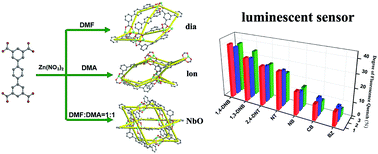Three new metal–organic frameworks (MOFs) constructed from terphenyl-3,3′′,5,5′′-tetracarboxylic acid (H4ptptc) and zinc nitrate, [Zn2(ptptc)(DMF)3]·4H2O·5.5DMF (1), [Zn2(ptptc)(DMA)(H2O)]·2.5H2O·3.5DMA (2) and [Zn(ptptc)0.5(H2O)]·DMF·DMA (3), have been obtained and characterized. All the complexes exhibit 3D 4-connected networks with different topologies involving diamond (dia, for 1), lonsdaleite (lon, for 2) and Nbo (for 3), which emanate from the different reaction solvents (DMF, DMA and mixture of DMF/DMA (1 : 1), respectively). The results of photoluminescence properties show that the three complexes can be act as potential luminescent probes or sensors for detecting small organic molecules and toxic substances.

